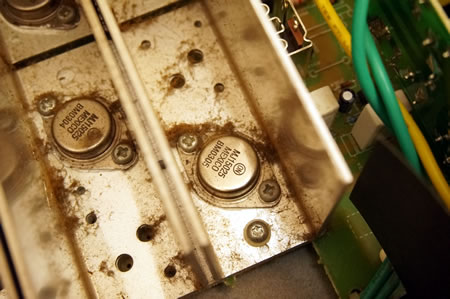 |
|
| When this amp came to me, the complaint was no lights, no fans when switched on. So I did precisely that and nothing happens. Normally, this indicates a blown fuse. However, this Crown uses a circuit breaker and it did not pop out which I thought was a bit odd. Well, time to see what’s under the hood.
With the top removed, there’s no sign of any burnt parts which is encouraging. Since the breaker didn’t pop, it means that current is going into the transformer. I did a quick test by powering up for a couple of seconds and true enough, the current limiting resistor of the inrush circuit was hot to the touch. This indicates that one or more power output transistors have blown. |
|
 |
 |
| Flipping over the paper flaps on the heatsinks reveal the power transistors. There are four TO-3 per channel (MJ15024/25). I noticed the heatsinks are in two parts, an indication that the power supply rails are connected to the heatsinks. This was confirmed by a warning label on one of the heatsinks. | |
 |
|
| In order to access the power transistors, the entire pcb must be removed from the chassis. Fortunately, it’s not too troublesome. Simply unscrew all the attachments. | |
 |
|
| With the pcb removed, the entire module was thoroughly cleaned before any work began. After all the grime and dust were removed, all the power transistors were de-soldered and tested. As I expected, there was one dead. As a precaution, all four power transistors were removed from that offending channel and replaced with new ones. | |
 |
|
| Now that the new power transistors are soldered in, the module is powered up with my bench power supply. With a scope connected to the output, no signs of instability was seen. | |
 |
|
| Secured with the knowledge that there are no other issues, the amplifier is re-assembled back into the chassis. Powered up and the front lights came on, fans rotate. With a signal generator connected, my scope showed a perfect sine wave with the tips clipping at rail voltages. Note the heatsink is at 69.658Vdc. So, remember not to touch the heatsink. |
|
| Next was to see how well it produce a square wave.
The image on the right is of a 10kHz square wave from the output of the repaired channel. It shows a very clean output, no overshoot on the leading and trailing edges. Both channels were tested and verified to have exactly the same performance. |
 |
 |
|
| The final test was to play music with the XLS202. It was connected to the speaker on the left, one channel was driving the compression driver while the other channel was driving the woofer. This is a bi-amp setup. An electronic crossover was situated before the power amplifier.
Musical reproduction was clean. No distortion was heard from the woofer as well as the horn. |
|
| DISCLAIMER
AmpsLab takes no responsibility for any loss, injury or death howsoever caused resulting from, whether directly or indirectly, the reader’s inability to understand and appreciate the hazards of household mains or other voltages as may be applicable to any published material. All mains wiring should be performed by suitably qualified persons only. |
|

December 23, 2016Amplifiers